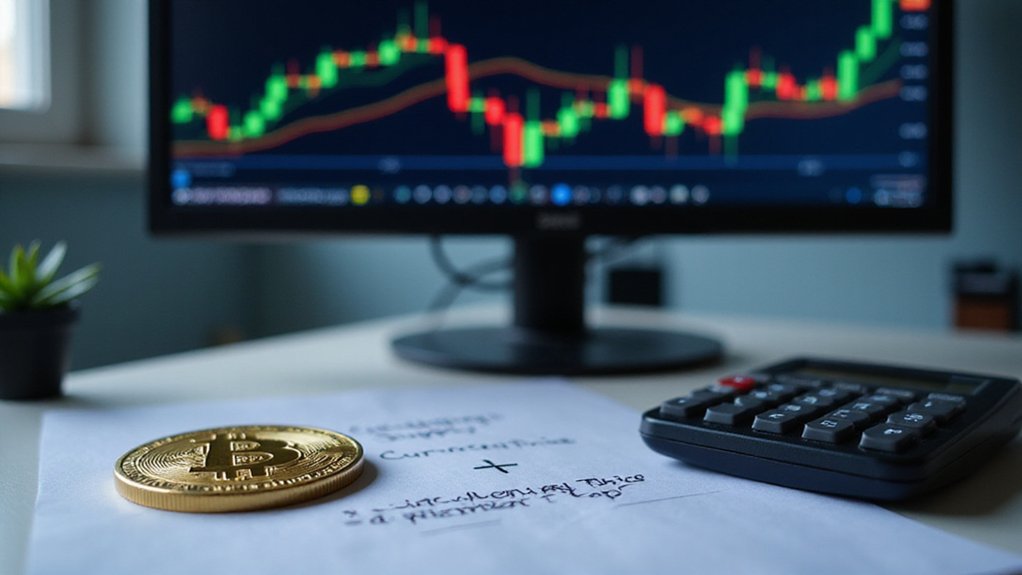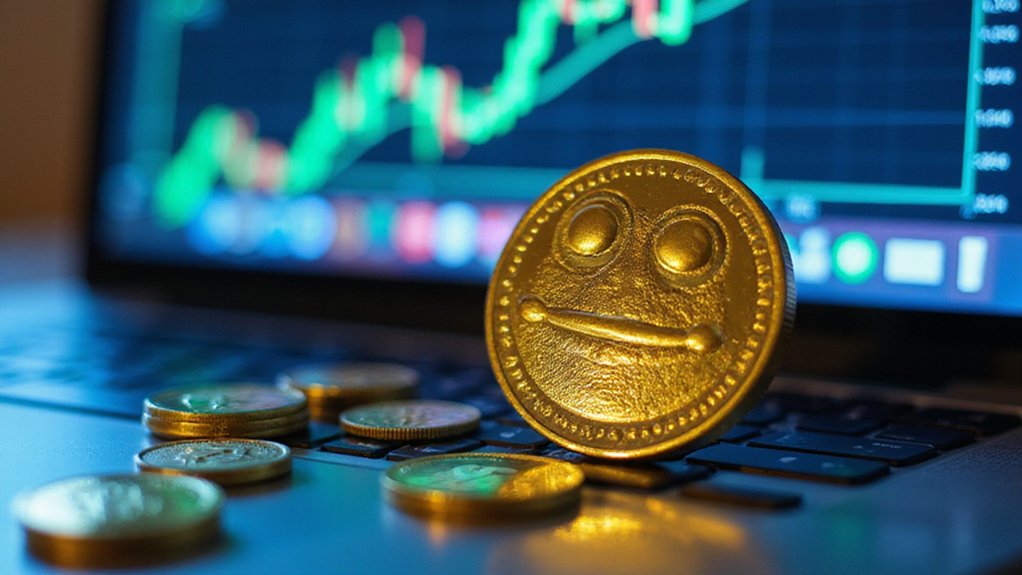Cryptocurrency market cap calculation employs strikingly straightforward mathematics: multiply the circulating supply by the current price. This elegantly simple formula—not theoretical maximums, mind you, but actual coins in circulation—yields the definitive economic footprint of any digital asset. Bitcoin’s staggering $1.34 trillion valuation exemplifies how this metric serves as the de facto measuring stick for comparing blockchain projects. Supplementing this calculation with trading volume analysis reveals whether a project’s valuation stands on substance or merely speculative fervor.

Understanding market capitalization—the cornerstone metric for evaluating cryptocurrency value—requires nothing more than elementary multiplication, yet its implications ripple through the entire digital asset ecosystem with remarkable complexity.
The formula itself embodies elegant simplicity: multiply the circulating supply of coins by the current market price.
In cryptocurrency valuation, the most profound insights emerge from the simplest equation: coins in circulation multiplied by current price.
This deceptively straightforward calculation yields a figure that investors scrutinize with near-religious devotion when comparing digital assets.
Market cap serves as the de facto measuring stick for cryptocurrency size and relative importance.
When analysts reference Bitcoin’s dominance or classify altcoins as “large cap” or “small cap” investments, they’re invoking this fundamental metric.
The calculation allows for immediate cross-comparison between disparate blockchain projects—regardless of individual coin prices—revealing their true economic footprint.
The process demands precision in identifying the actual circulating supply (not theoretical maximum supply, which would yield the fully diluted market cap and potentially misrepresent current valuation).
For instance, a cryptocurrency with 10 million coins in circulation trading at $10 per coin commands a $100 million market cap.
Straightforward arithmetic, profound implications.
Market cap fluctuates dramatically in cryptocurrency markets, where volatility reigns supreme.
Price movements instantly transform market capitalizations, occasionally birthing or destroying billions in notional value within hours.
Supply mechanisms—mining rewards, token burns, vesting schedules—further complicate the picture by altering the circulating supply component of the equation.
As of July 2024, Bitcoin maintains its position as the dominant cryptocurrency with a market cap exceeding $1.34 trillion.
While market cap dominates valuation discussions, savvy analysts supplement this metric with examinations of trading volume, network activity, and market share.
These additional indicators provide vital context for interpreting whether a cryptocurrency’s market cap reflects genuine economic activity or merely speculative froth.
Numerous online calculators facilitate instant market cap calculations, though the underlying math hardly warrants technological assistance.
What remains challenging isn’t the calculation itself but rather interpreting what the resulting figure actually signifies in a market where traditional valuation principles often appear suspended—a peculiar reality that continues to fascinate and frustrate financial traditionalists in equal measure.
The same calculation method works across various currencies, allowing investors to calculate Bitcoin’s market cap in USD or Euros depending on their preferred fiat reference point.
Some investors also consider FDMC values when evaluating potential long-term investment risks associated with cryptocurrencies that have substantial token supplies yet to be released into circulation.
Frequently Asked Questions
How Does Market Cap Affect Cryptocurrency Price Volatility?
Market capitalization inversely correlates with cryptocurrency price volatility.
Larger market cap assets (Bitcoin being the quintessential example) exhibit markedly reduced volatility due to enhanced liquidity, broader holder distribution, and institutional participation.
Their substantial trading volumes absorb large orders without dramatic price swings—a luxury smaller-cap tokens can’t afford.
As cryptocurrencies mature, their volatility tends to decrease (Bitcoin’s sub-50% realized volatility being a rarity worth noting), creating a more stable investment profile that attracts risk-averse capital and regulatory confidence.
Can Market Cap Predict Future Crypto Investment Performance?
Market cap cannot definitively predict future crypto performance, though it serves as one indicator within a constellation of metrics.
While larger caps typically suggest enhanced stability (and, perhaps, less astronomical returns), they’re hardly crystal balls in this notoriously capricious domain.
Savvy investors recognize market cap as merely one puzzle piece—alongside technological fundamentals, regulatory landscapes, and adoption trends—rather than a prophetic tool.
The crypto market’s inherent volatility renders any single metric insufficient for forecasting tomorrow’s winners and losers.
Why Do Some Low Market Cap Coins Outperform Higher Ones?
Low market cap cryptocurrencies often outperform their larger counterparts due to their inherent volatility and growth potential.
These smaller coins—typically under-the-radar projects with innovative technologies or strong community backing—require less capital influx to dramatically increase in value (a mere $1 million investment can move the needle considerably).
While high-cap coins offer stability, their established market positions paradoxically limit explosive growth potential.
The financial asymmetry creates opportunity for disproportionate returns, albeit with corresponding risk profiles.
How Frequently Do Cryptocurrency Market Caps Get Updated?
Cryptocurrency market caps receive near-continuous updates throughout the trading day.
Major aggregators like CoinMarketCap and CoinGecko refresh these figures multiple times per minute—a necessity in markets where billions in value can materialize (or evaporate) during bathroom breaks.
The calculations combine real-time price feeds from exchanges with circulating supply data, though supply updates occasionally lag price refreshes.
This high-frequency approach enables traders to witness market gyrations as they unfold, for better or worse.
What Causes Sudden Market Cap Changes During Cryptocurrency Crashes?
Cryptocurrency market caps plummet during crashes primarily through a perfect storm of interrelated factors.
Panic selling (that most predictable of human foibles) creates supply-demand imbalances, while whale investors exacerbate volatility through large-scale liquidations.
Negative news catalyzes these movements, spreading with viral efficiency across investor communities.
Regulatory announcements—often ill-timed or poorly articulated—can trigger institutional flight, while market manipulation schemes occasionally lurk behind seemingly spontaneous collapses.
Low liquidity in smaller coins amplifies these effects, creating cascading selloffs.









